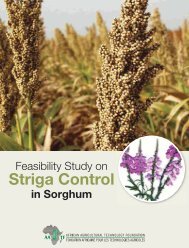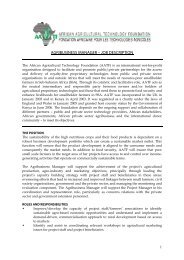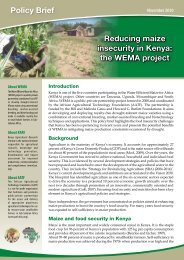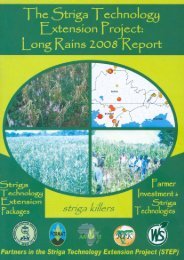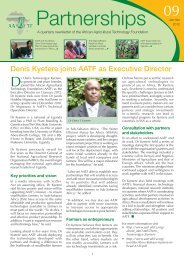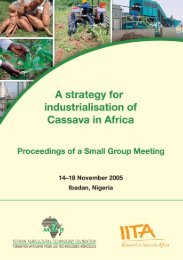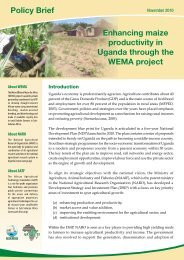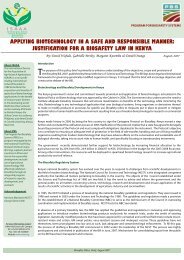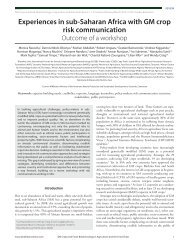Baseline Study of Striga Control using IR Maize in Western Kenya
Baseline Study of Striga Control using IR Maize in Western Kenya
Baseline Study of Striga Control using IR Maize in Western Kenya
Create successful ePaper yourself
Turn your PDF publications into a flip-book with our unique Google optimized e-Paper software.
livelihoods. Households with the follow<strong>in</strong>g characteristics are more likely to be poor: <strong>Striga</strong>has been on the farm for long; high perceived yield loss to <strong>Striga</strong> while depend<strong>in</strong>g heavily onmaize for household <strong>in</strong>come; lack <strong>in</strong>tegrated <strong>Striga</strong> control; high dependency ratio; headed byolder farmers; low educational atta<strong>in</strong>ment; non-adopters <strong>of</strong> technology; poor access to landand farm assets, depend on credit; no <strong>of</strong>f-farm work; no cash crops; and live <strong>in</strong> environmentswith characteristics similar to those <strong>of</strong> Bondo and Vihiga districts.6. Food shortage can last as long as five months <strong>in</strong> a year and it occurs every year for morethan 70% <strong>of</strong> households. Cop<strong>in</strong>g strategies <strong>in</strong>clude <strong>of</strong>f-farm short-term jobs, disposal <strong>of</strong>assets, and <strong>in</strong>formal safety nets especially through remittances received from relatives. Theabove f<strong>in</strong>d<strong>in</strong>gs on household vulnerability were gathered from respondents’ perceptions. Theresults from this qualitative assessment were confirmed by those from quantitative analyseson the anthropometric <strong>in</strong>dices on children and women. The Z scores calculated on children<strong>in</strong>dicate that about 30% were wast<strong>in</strong>g, 50% were underweight and 48% were stunted.Therefore, the identified vulnerability is reflected <strong>in</strong> both <strong>in</strong>dicators <strong>of</strong> short term exposure t<strong>of</strong>ood <strong>in</strong>security (underweight) and those on long-term exposure to food <strong>in</strong>security (stunt<strong>in</strong>g).The magnitude <strong>of</strong> the malnutrition on children is beyond any prediction <strong>in</strong> a country at peace.Similarly, the results on BMI on women showed that 36% were underweight while 18% wereoverweight. One would expect only cases <strong>of</strong> underweight for food <strong>in</strong>secure households.However, the presence <strong>of</strong> cases <strong>of</strong> obesity <strong>in</strong> that environment is not strange to nutritionists.They characterise this contrast<strong>in</strong>g situation as nutrition <strong>in</strong> transition (Sanusi et al, 2005). It istypical <strong>of</strong> poor households but it is also common <strong>in</strong> wealthy countries. For households thatdepend on agriculture for their livelihoods, the only approach to break the above vulnerabilityis to <strong>in</strong>crease the production and productivity <strong>of</strong> crops. For western <strong>Kenya</strong>, <strong>in</strong>terventionsshould target maize. There is also need to look <strong>in</strong>to additional strategies through thediversification <strong>of</strong> farm<strong>in</strong>g enterprises.7. A translog stochastic frontier production function <strong>in</strong>corporat<strong>in</strong>g a model for technical<strong>in</strong>efficiency effects was used to analyse the technical efficiency <strong>of</strong> maize farmers <strong>in</strong> western<strong>Kenya</strong>. The results showed both gender and location differentials <strong>in</strong> maize productivity.Gender differentials <strong>in</strong> productivity were more apparent <strong>in</strong> Nyanza than <strong>in</strong> <strong>Western</strong> prov<strong>in</strong>ce.Adoption <strong>of</strong> hybrid maize and traditional <strong>Striga</strong> control <strong>in</strong>creased maize production. Thesampled maize farmers achieved an average technical efficiency <strong>of</strong> 62%, <strong>in</strong>dicat<strong>in</strong>g aconsiderable potential (38%) for <strong>in</strong>creas<strong>in</strong>g maize production through improved efficiencyand better practices such as <strong>in</strong>tegrated <strong>Striga</strong> control. An exam<strong>in</strong>ation <strong>of</strong> the relationshipbetween efficiency and socioeconomic attributes revealed that while technical efficiency<strong>in</strong>creased with educational atta<strong>in</strong>ment, it has turned out to have a non-l<strong>in</strong>ear relationship withage and farm size. Technical efficiency first <strong>in</strong>creases with age and farm size but eventuallydecl<strong>in</strong>es with age and farm size. The result relat<strong>in</strong>g to the direct farm size–efficiencyrelationship for smaller hold<strong>in</strong>gs coupled with the fact that most farmers cultivate t<strong>in</strong>y plots<strong>of</strong> land suggests that re-allocation <strong>of</strong> more land to maize would enhance farmer efficiency.Increased efficiency could be achieved through, for <strong>in</strong>stance more optimal application <strong>of</strong><strong>in</strong>puts and greater <strong>in</strong>tensity <strong>of</strong> adoption <strong>of</strong> improved maize varieties. Therefore, efforts mustbe made to enhance adoption <strong>of</strong> both hybrid maize (and hence fertiliser) and <strong>Striga</strong> controltechnologies to help <strong>in</strong>crease maize production. <strong>Maize</strong> yields <strong>in</strong> <strong>Kenya</strong> have cont<strong>in</strong>ued todecl<strong>in</strong>e despite <strong>in</strong>creased use <strong>of</strong> new maize varieties, largely because <strong>of</strong> lack <strong>of</strong> effective<strong>Striga</strong> control technologies. Promot<strong>in</strong>g both high-yield<strong>in</strong>g varieties and <strong>Striga</strong> controltechnologies should thus be an important goal for research and extension <strong>in</strong> <strong>Kenya</strong>. In thisregard, AATF’s <strong>IR</strong> maize technological <strong>in</strong>tervention for <strong>Striga</strong> control holds considerable50




